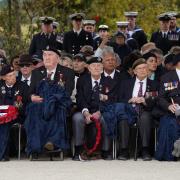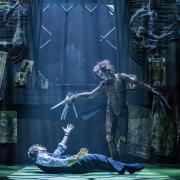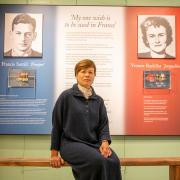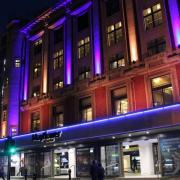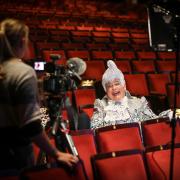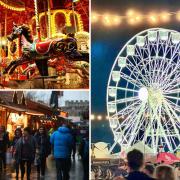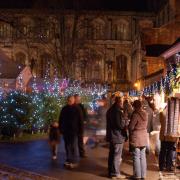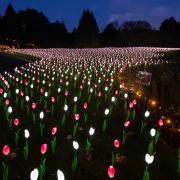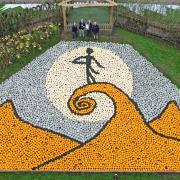70 years ago the Normandy beach landings by allied forces marked the start of the liberation of Western Europe.
When the Supreme Allied Commander US General Dwight Eisenhower uttered the immortal words, “OK, let’s go”, it signalled a turning point in WW2. The mass assault into enemy held territory by sea and air on 6 June 1944 was, however, no snap decision. As many of those living, working or temporarily based in Portsmouth were only too aware, plans for the Battle of Normandy, code-named Operation Overlord, had been taking shape for months.
“From August 1943 the whole of Southsea seafront was a restricted area, so you had to have a security pass just to come down here,” says Andrew Whitmarsh, curator at the D-Day Museum. Defences installed against possible German attack meant beach access had already been suspended for some time. And the nearby naval dockyard remained on high alert against a repeat of earlier devastating air raids. Should reminders be needed of the city’s vulnerability, museum exhibits reveal 930 people were killed and one in five homes damaged or destroyed during the conflict.
So, not surprisingly, although hotels, guest houses and other buildings were commandeered for the war effort, tens of thousands of troops awaiting embarkation occupied sealed camps on Portsmouth’s outskirts. Andrew explains: “They were then brought down to the ships and the landing craft at the last minute. Beforehand, most were hidden in woods and camouflaged by the trees to preserve the secrecy. But you also had vehicles parked up on roadsides, which might be there for days at a time, and that was when troops and the local people sometimes got to know each other.
“There are reports of soldiers unofficially being invited in to share a meal and being allowed to take a bath. We’ve got a coat, on display, worn by a five-year-old girl which has got an array of badges given to her by troops leaving from Gosport.”
Although some civilians retreated from the city centre, countless numbers helped prepare the military. At the former Airspeed factory the Horsa glider, used by both British and Canadian forces, was built. And Priddy’s Hard, now the museum Explosion! continued its long history as a centre for naval firepower. Interestingly, construction of the famous Mulberry Harbours saw an Irish workforce brought-in, before components were shipped-out and re-assembled across The Channel.
From famous map rooms to subterranean monitoring centres, it’s still possible to soak-up some of the D-Day atmosphere around the city’s secure sites during special public openings. And even shoppers to Gunwharf Quays’ designer outlets get a few hints that it was once HMS Vernon, a base for S Force which landed British troops on Sword Beach, and for motor torpedo boats.
The D-Day Museum however, remains the place to head for to get the full story behind these momentous events, and plans are afoot to completely transform the way it’s told. Andrew says: “Over the years we’ve built up a big archive collection, including interviews with veterans, and want to make more use of these. By 2017 it will be a new museum. Hopefully, you will still get the same feeling as you go round. In a way it’s a memorial, but, we’ll become the national hub for all things D-Day.”
A veteran’s story - Frank Rosier: Private, 2nd Battalion Gloucestershire Regiment
The 18-year-old Londoner landed in the second wave on Gold Beach, having trained on Hayling Island for the assault. On D-Day his unit was attached to the 50th Division, tasked with taking Bayeux. They left from Southampton, another key marshalling area, at 5pm.
Frank tells his story: “The crossing took about five hours but they delayed our landing until 10.30am the following morning because the Dorset Regiment ahead of us hadn’t yet left the beach. Imagine what it was like: the smoke, the engine oil, half of us being sick. Whatever was facing us, we just wanted to get off that boat.
“I’d never seen a dead person in my life. And the carnage on the beach stopped us for a few seconds - that’s what always sticks in my mind. I won’t ever try to describe it. The Germans had put the beach defences at high tide and they landed us at low tide, with 40 to 50 yards of open beach - it was a very dangerous place.
Our platoon - the officers, NCOs and men, they’d become your family, virtually brothers. We’d lived and trained together 24/7. Our orders on the day were: if your mate got hit, you left him there. You just had to get off that beach. Luckily for us, we had very light casualties: one killed and six wounded.”
Three months later, Frank was injured during fierce fighting near Le Havre. He’s since been awarded France’s highest award the Légion d’Honneur, for his work with the Normandy Veterans’ Association.
“As a nation I think we’re a bit blasé about our freedom,” says Frank. “We take it for granted. But it’s such a precious thing.”




